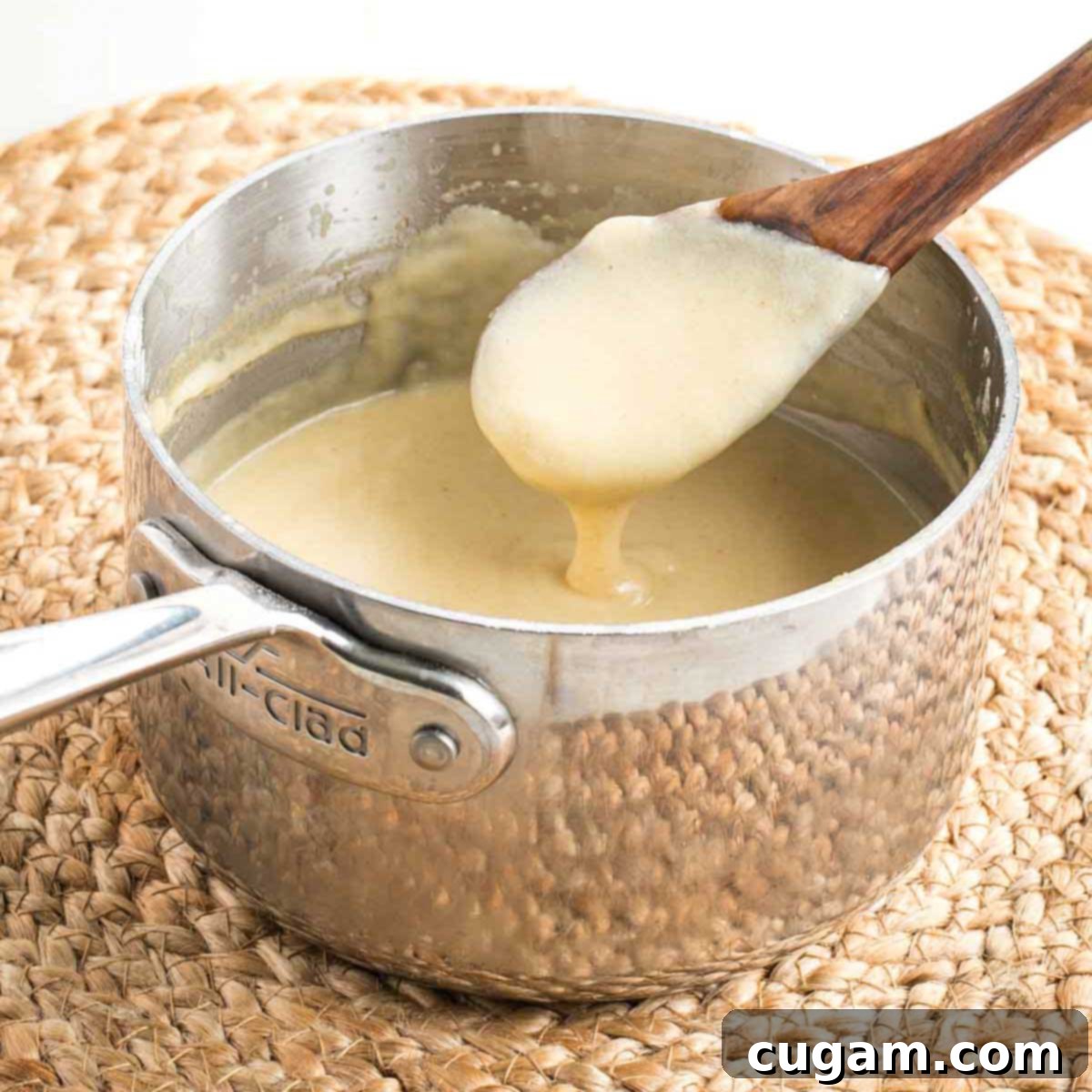Irresistible Vegan Bechamel Sauce: Creamy, Dairy-Free & Gluten-Free White Sauce for Every Dish
Discover the magic of this Vegan Bechamel Sauce, elevated with a subtle yet impactful hint of miso paste. The result is an unbelievably smooth, rich, and utterly irresistible dairy-free white sauce that will revolutionize your plant-based cooking. Crafted with wholesome ingredients like high-quality olive oil and gluten-free cassava flour, this creamy sauce is not only vegan and gluten-free but also incredibly versatile. It ensures that everyone, regardless of dietary restrictions, can indulge in their favorite comfort foods, from classic veggie lasagna and hearty pot pies to a myriad of delicious pasta dishes that traditionally call for a classic white sauce.
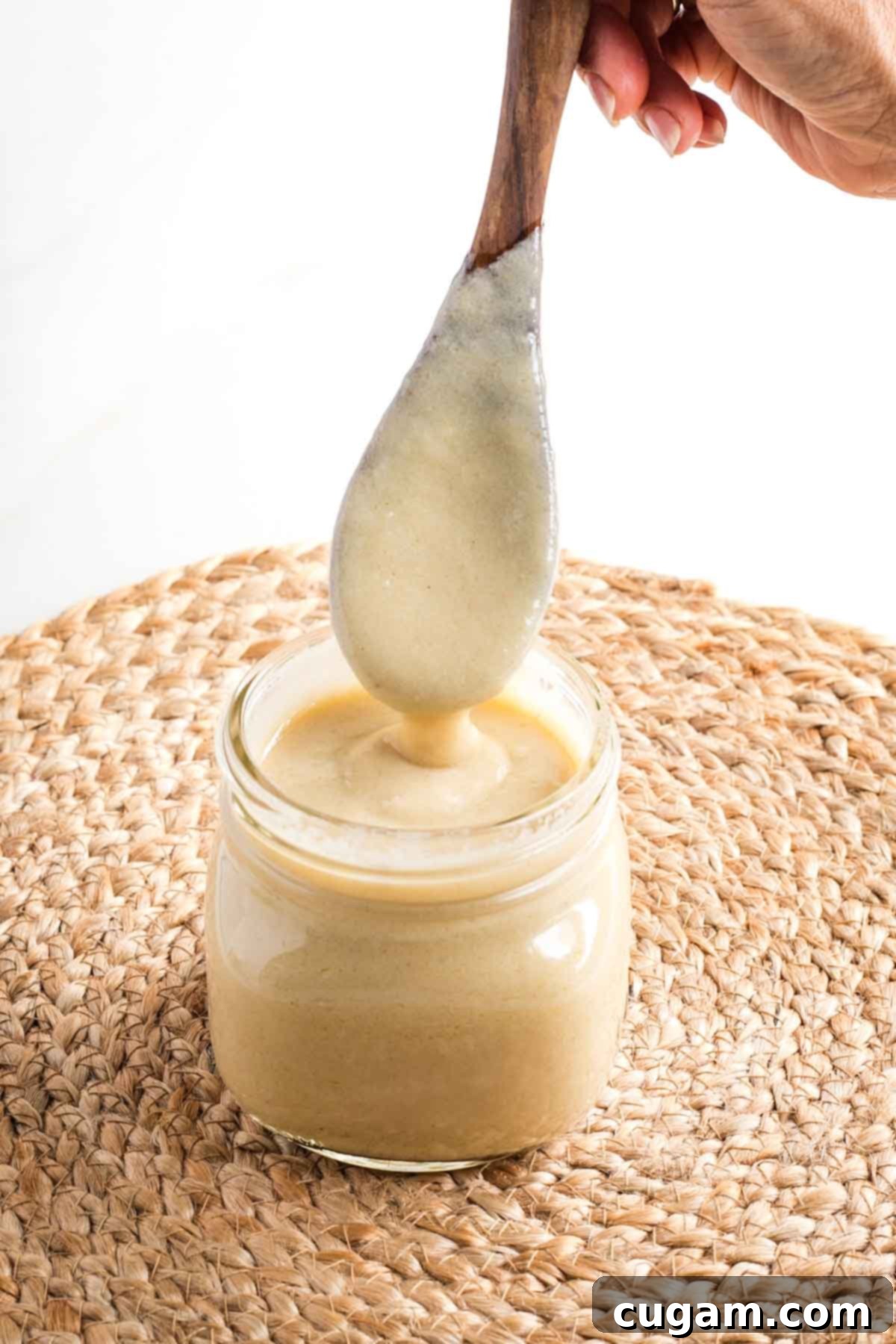
A truly exceptional bechamel sauce serves as the fundamental building block for countless beloved dishes. If you’ve been navigating the culinary world on a gluten-free or dairy-free diet, prepare for some fantastic news! This vegan white sauce achieves the same luscious, thick, and creamy consistency as a traditional béchamel, making it a perfect, inclusive option for those with sensitivities to gluten or dairy. No longer will you miss out on the comforting richness this foundational sauce provides; it’s here to transform your meals!
[feast_advanced_jump_to]
Why You’ll Fall in Love with This Vegan Bechamel Sauce
This isn’t just another substitute; it’s a superior, healthier alternative that brings incredible flavor and versatility to your kitchen. Here’s why this dairy-free and gluten-free white sauce will become your new go-to:
- Completely Vegan & Dairy-Free: Crafted with olive oil and plant-based milk (specifically cashew milk in our primary recipe), this sauce is 100% free from animal products. It’s a fantastic choice for ethical vegans, those with lactose intolerance, or anyone looking to reduce their dairy intake for health or environmental reasons. You won’t believe how rich and creamy it is without any dairy at all!
- Naturally Gluten-Free: By utilizing cassava flour, we’ve created a white sauce that is naturally free of gluten. This makes it an ideal option for individuals with Celiac disease or gluten sensitivities, allowing them to enjoy classic dishes without compromise. Cassava flour provides a silky texture that rivals traditional wheat flour in a roux.
- Quick & Effortless to Make: Forget long, complicated recipes. This delightful sauce comes together in approximately 10 minutes of active cooking time, making it perfect for busy weeknights or when you need a speedy culinary solution.
- Incredibly Versatile Base: This vegan béchamel isn’t just a standalone sauce; it’s a brilliant foundation for more elaborate creations. Use it as a starting point to develop cheese sauces (add nutritional yeast!), herb sauces, or even a creamy mushroom sauce. The possibilities are endless!
- Perfect for a Multitude of Dishes: From layering in a decadent lasagna to adding a creamy element to pot pies, enriching pasta dishes, or making a luscious vegan mac and cheese, this sauce is your dairy-free answer. It provides the essential creaminess and depth of flavor needed to transform ordinary meals into extraordinary culinary experiences.
Understanding Bechamel: Traditional vs. Vegan
Traditional béchamel, one of the five French mother sauces, is typically made by whisking butter and flour to create a roux, then gradually adding dairy milk and cooking until thickened. It’s known for its smooth, velvety texture and mild flavor, forming the base for many classic dishes like lasagna, gratins, and soufflés. However, for those avoiding dairy or gluten, enjoying this culinary staple has historically been a challenge.
This vegan and gluten-free béchamel sauce brilliantly re-engineers the classic, replacing butter with olive oil and dairy milk with plant-based alternatives. The result is a sauce that maintains the beloved creamy texture and versatility without any dairy or gluten, making it accessible and enjoyable for a broader audience. Our secret ingredient, miso paste, adds an incredible depth of umami flavor that compensates for the richness typically provided by butter, creating a truly unforgettable experience.
Essential Ingredients and Smart Substitutions
Creating this delicious vegan béchamel requires just a handful of simple, wholesome ingredients. Here’s a closer look at what you’ll need and how you can adapt it to your preferences:
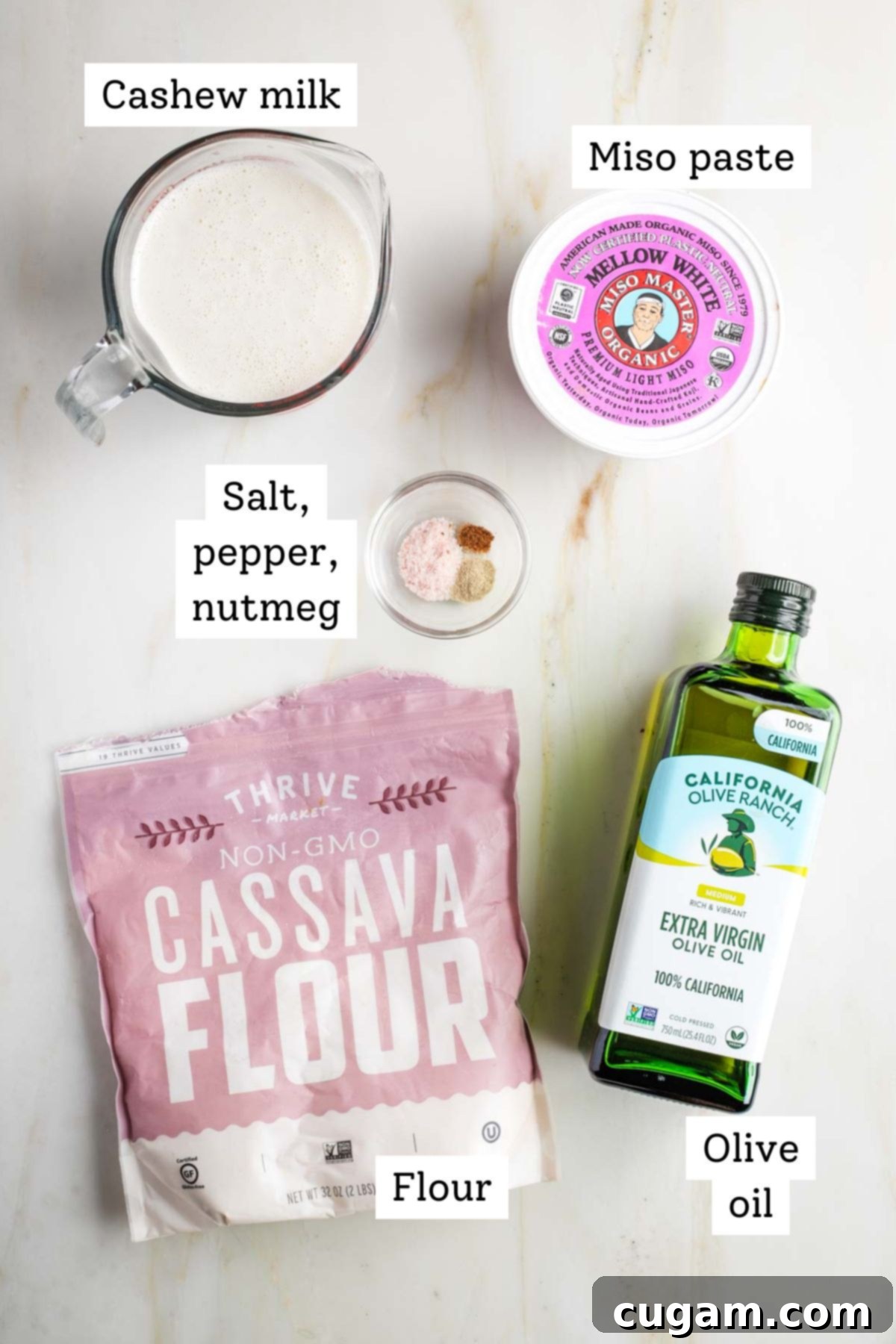
- Plant-Based Milk: For an exceptionally creamy and neutral base, I highly recommend using unsweetened cashew milk. Its natural richness and smooth texture are perfect for béchamel. If you’re feeling adventurous, you can easily make your own cashew milk by soaking ½ cup raw, unsalted cashews in boiling water for 30 minutes, then rinsing, draining, and blending with 2 cups of fresh water until silky smooth. Alternatively, other excellent dairy-free choices include unsweetened soy milk, oat milk, or almond milk. Each will offer a slightly different flavor profile and consistency, with oat milk often being a popular choice for its creaminess.
- Miso Paste (The Secret Ingredient): Light miso paste is the game-changer here. This fermented soybean paste adds an incredible depth of savory, umami flavor that beautifully rounds out the sauce and provides a richness traditionally associated with butter. It’s a subtle yet essential component that elevates this vegan white sauce from good to truly extraordinary. Don’t skip it if you want that ultimate flavor boost!
- Olive Oil: A good quality olive oil forms the fat base for our roux, contributing a pleasant, subtle flavor and healthy fats. If you’re aiming for an oil-free sauce, you can achieve a similar texture by mixing 1 tablespoon of drippy tahini with 3 tablespoons of vegetable broth. Whisk this mixture until it’s uniform and use it in place of the olive oil. While it provides a good plant-based alternative, be aware that the final sauce might be slightly less rich and creamy than its oil-based counterpart.
- Gluten-Free Flour: Cassava flour is an exceptional gluten-free choice for this recipe, producing a smooth and consistent roux without the gritty texture sometimes found with other GF flours. Its neutral flavor ensures the sauce’s other ingredients shine through. You can also use other gluten-free all-purpose flour blends or even tapioca starch, oat flour, or chickpea flour, though results may vary slightly in texture and flavor. I often source my high-quality dry goods, including various flours, from Thrive Market, a great resource for specialty ingredients.
- Seasonings: A touch of sea salt, white pepper, and a pinch of nutmeg are essential. Salt balances the flavors, white pepper adds a subtle warmth without visible flecks, and nutmeg is a classic addition to béchamel, enhancing its savory notes.
How to Make It: A Step-by-Step Guide to Perfection
Crafting this luscious vegan béchamel sauce is simpler than you might think, but it does require a little patience and constant attention – primarily in the form of whisking! Dedicate about 10 minutes, and you’ll be rewarded with a creamy, lump-free sauce.
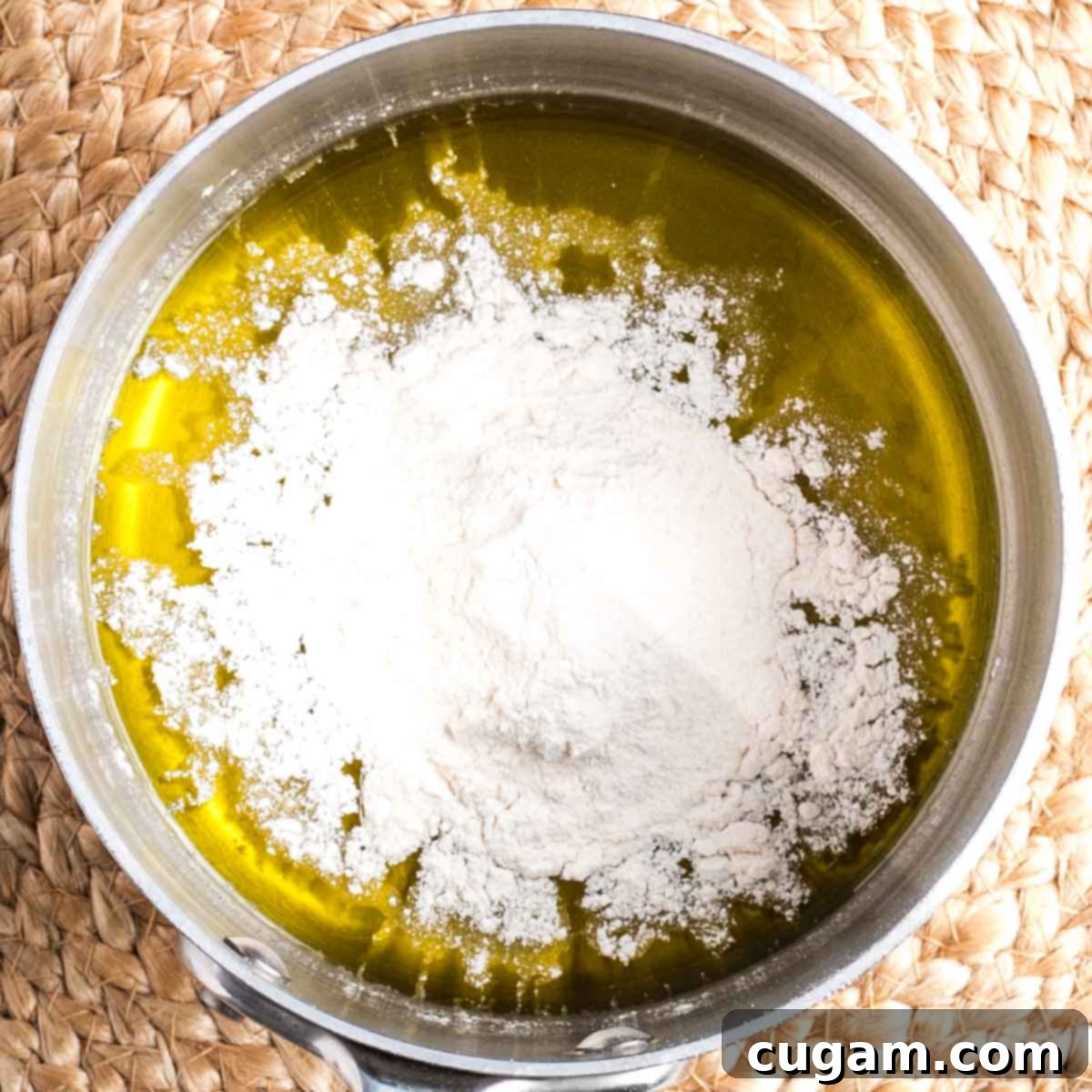
Step 1: Create the Roux. Begin by heating the olive oil in a small saucepan over medium-low heat. Let it warm for about 30 seconds. Then, sprinkle in the cassava flour. This initial mixture of fat and flour is known as a roux, the thickening agent for your sauce. Your goal here is to cook off the raw flour flavor, but be careful not to let it brown, as this will change the color and flavor of your white sauce. Whisk constantly during this stage; the mixture will quickly become very thick and pasty. Don’t worry if it seems to mostly cling to your whisk; that’s normal for a good roux.
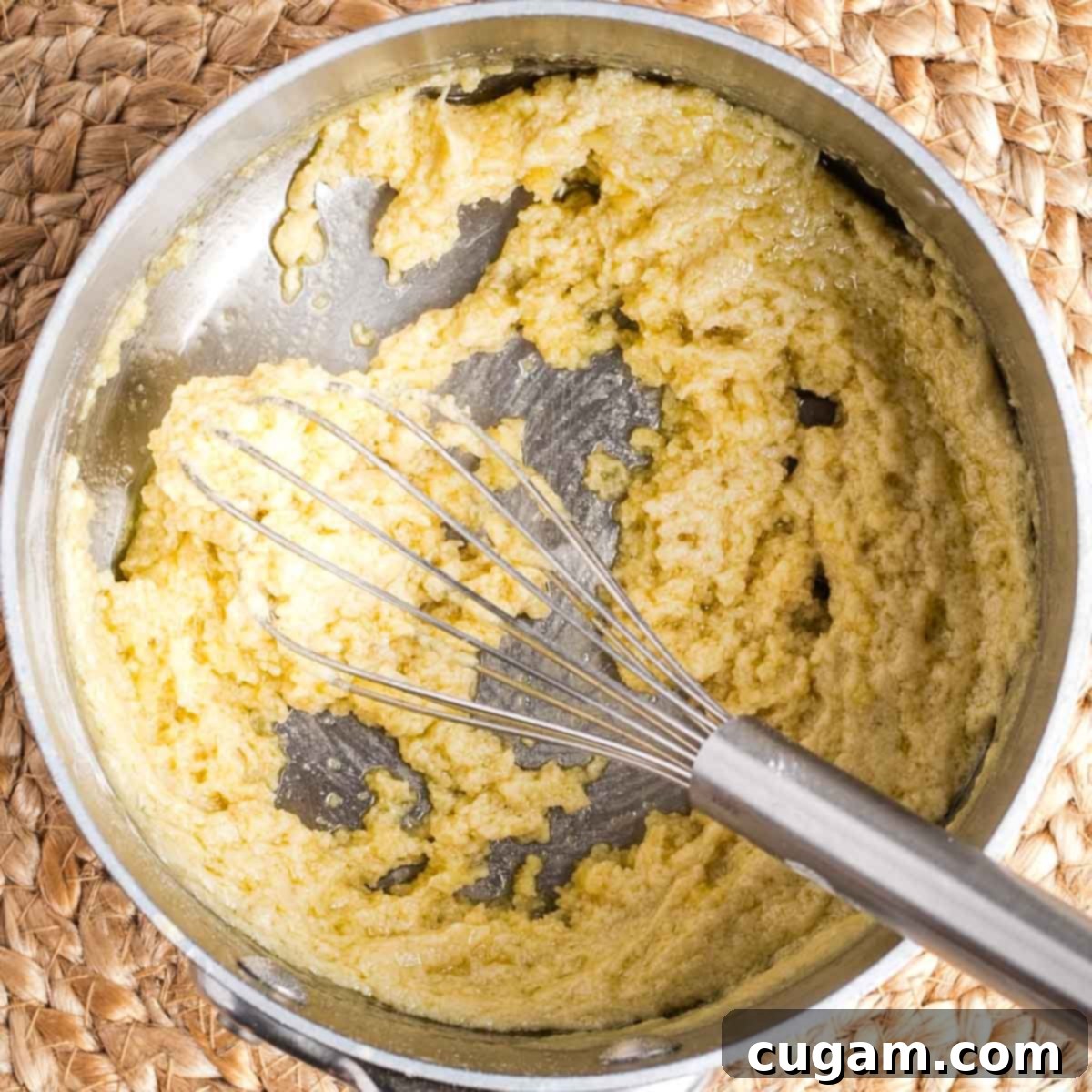
Step 2: Incorporate the Milk Gradually. Once your roux is ready, it’s time to introduce the plant milk. Pour in just a couple of tablespoons of the cashew milk and whisk vigorously and continuously. At first, the mixture might actually get even thicker as the flour absorbs the liquid. Keep whisking until a uniform, thick paste is achieved. This prevents lumps from forming later. It’s crucial to add the liquid slowly, allowing the flour to fully absorb each addition.
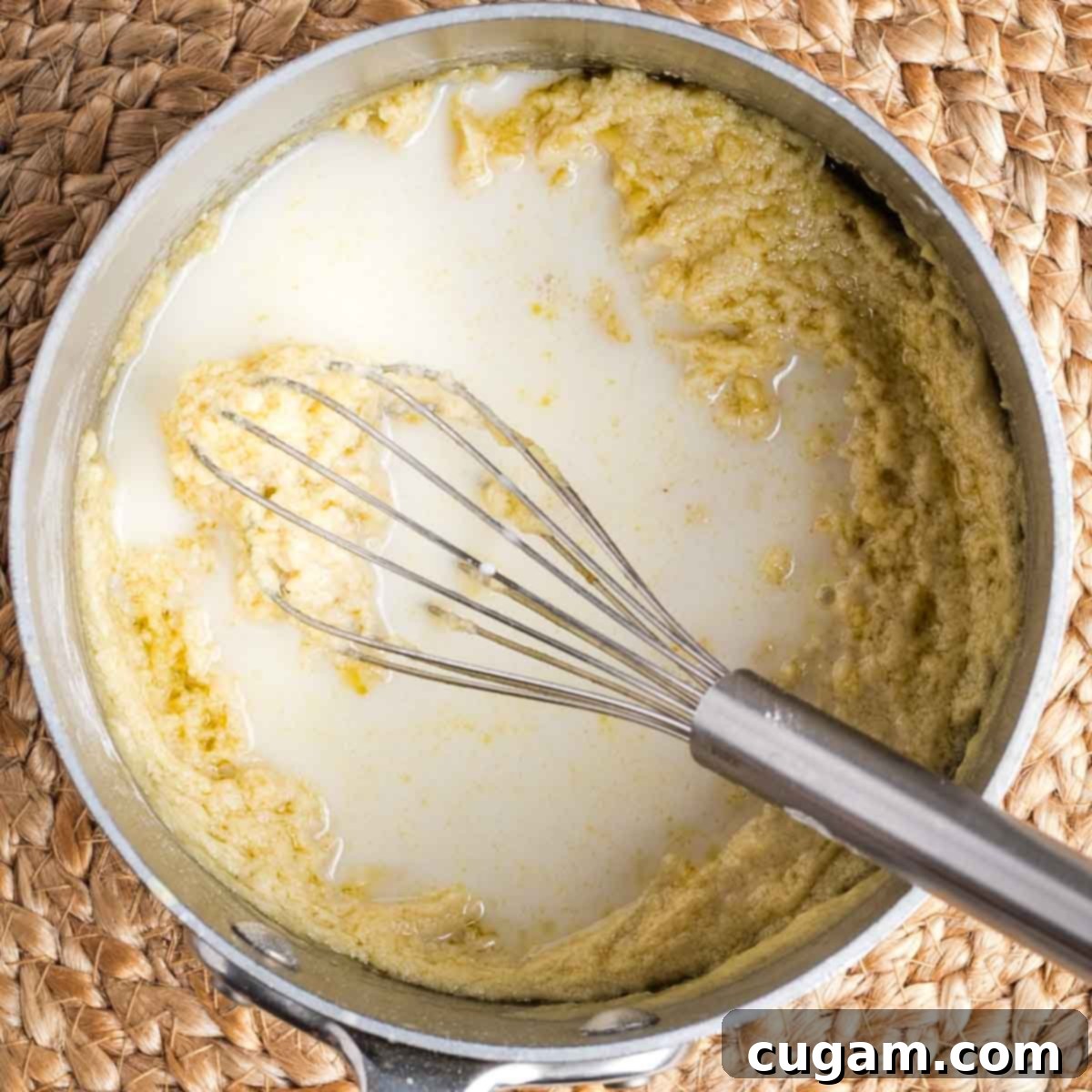
Step 3: Continue Adding Milk Slowly. Raise the heat slightly to medium. Continue to add the remaining plant milk very slowly, just a few tablespoons at a time, whisking constantly and thoroughly after each addition. The sauce will go through various stages – it might appear very thick, then thin out as you whisk in more milk and it heats up, then thicken again. This is a normal process! Keep observing and whisking until the liquid has been evenly dispersed and the sauce starts to thicken consistently. Do this until you have about ¼ cup of milk left.
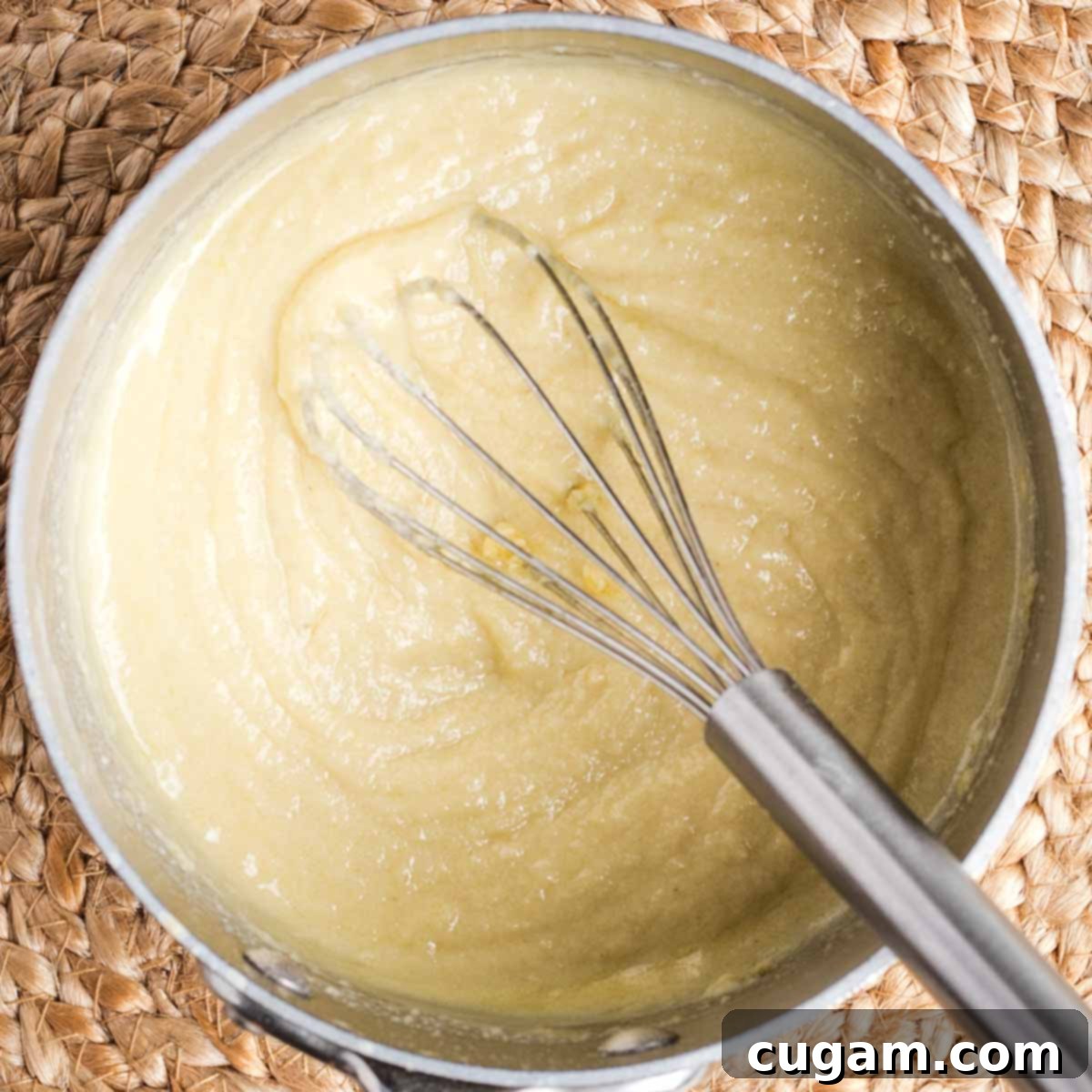
Step 4: The Miso Magic. As you approach the final ¼ cup of milk, take a moment to enhance your sauce with miso. In a separate small bowl or directly in the measuring cup, use a fork to thoroughly mix the light miso paste into this last portion of milk until it’s completely diluted and uniform. This ensures the miso is evenly distributed in the final sauce and prevents any clumps. Then, add this miso-milk mixture to your saucepan, whisking continuously until this last addition thickens up the sauce to your desired consistency. The sauce should now be smooth, creamy, and free of lumps.
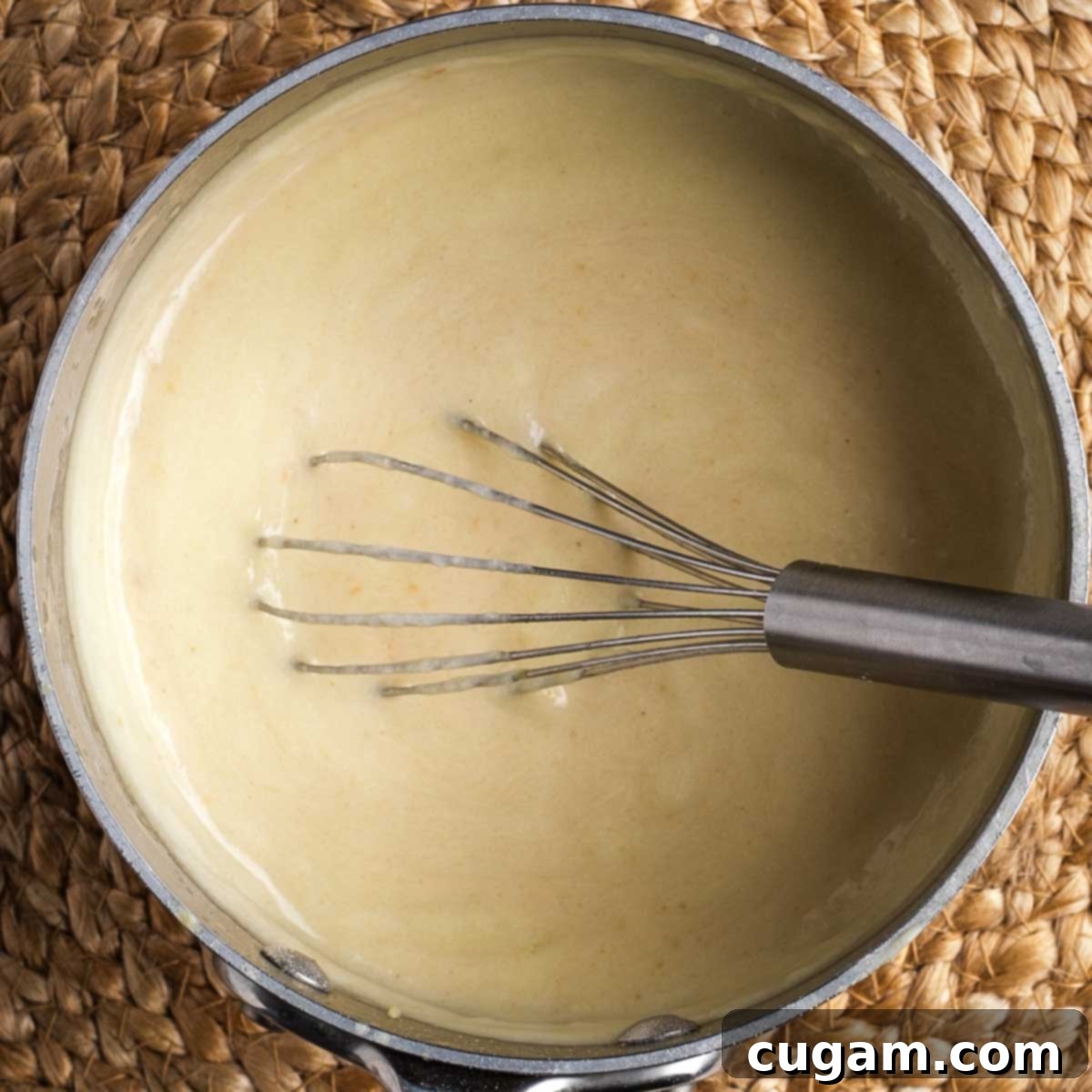
Step 5: Final Seasoning. Once the sauce has reached its perfect thickness and consistency, turn off the heat. Stir in the sea salt, white pepper, and a pinch of nutmeg. Give it one final whisk to ensure all seasonings are fully incorporated. Taste and adjust if necessary. The result should be a beautifully balanced, savory, and creamy vegan béchamel that’s ready to elevate your culinary creations.
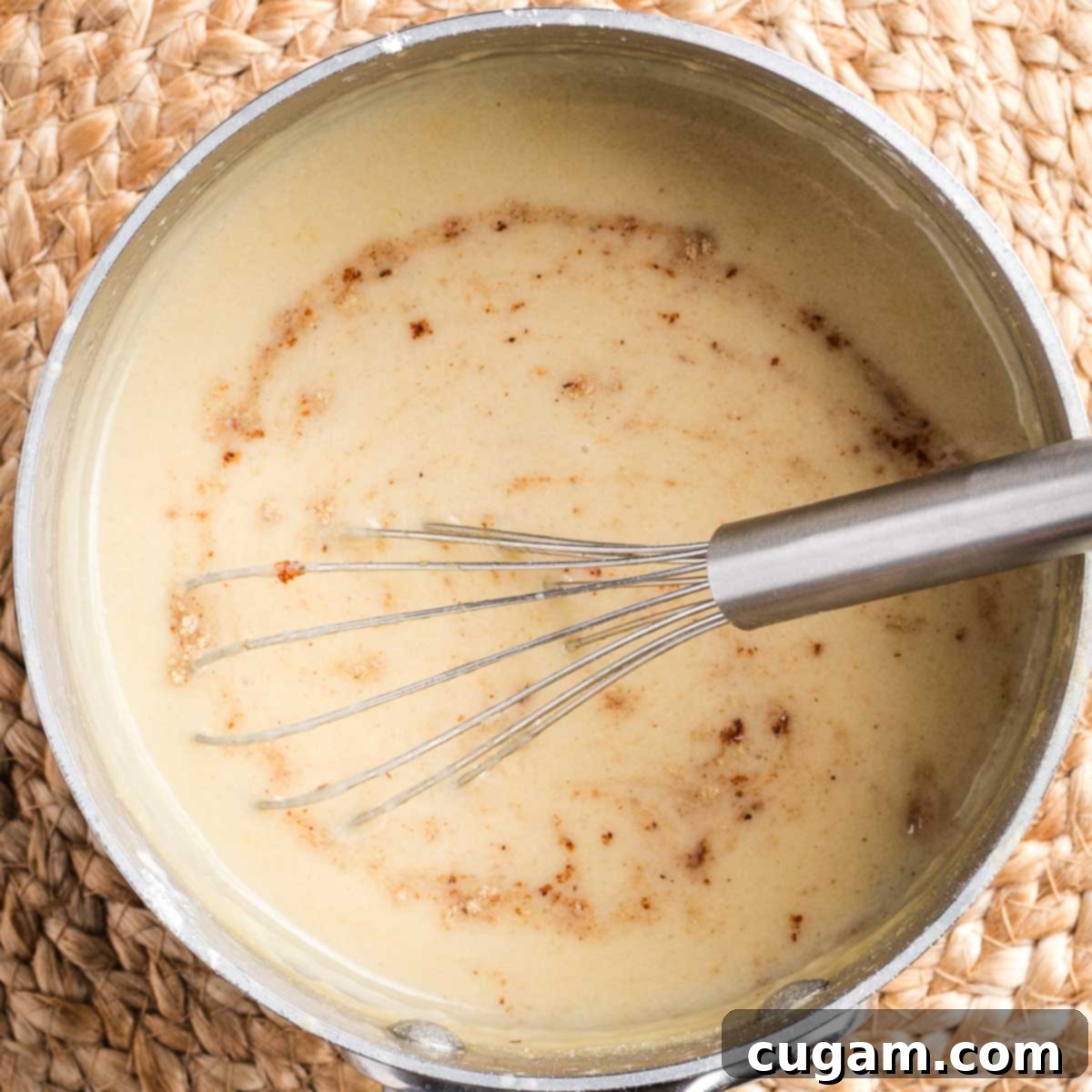
The finished béchamel sauce should be thick enough to generously coat the back of a spoon, leaving a clear trail when you run your finger across it. As the sauce cools, stir it occasionally to prevent a film from forming on the surface. Now it’s ready for use or storage!
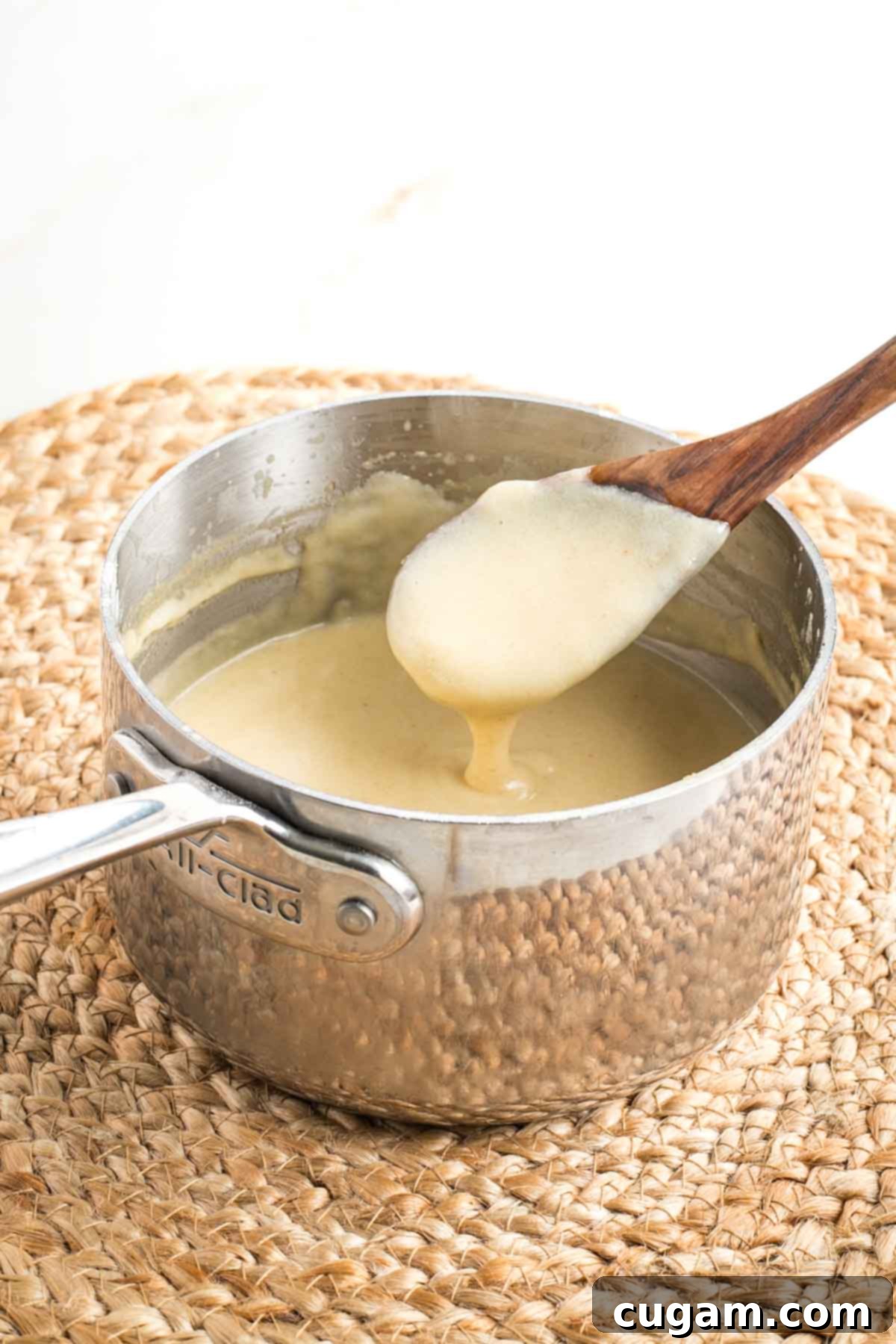
Debra’s Pro Tips for a Flawless Vegan Bechamel

Achieving a perfectly smooth and creamy vegan béchamel is all about technique. Keep these expert tips in mind for consistently excellent results:
- Mise en Place is Key: “Mise en place” means “everything in its place.” Before you even turn on the stove, gather all your ingredients and have them measured and within arm’s reach. You’ll be whisking almost constantly once you start, so you won’t have time to search for ingredients. This smooth workflow ensures success and prevents burning.
- Whisk, Whisk, Whisk Some More: Seriously, your whisk is your best friend here! Constant, vigorous whisking is crucial to prevent lumps from forming. As you add the flour to the oil and then the milk to the roux, continuous whisking ensures that everything is thoroughly combined and cooks evenly, resulting in a silky-smooth sauce. Don’t be shy with it!
- Room Temperature or Warm Milk is Best: Using cold milk straight from the refrigerator can shock the roux, increasing the chances of lumps forming. Ideally, allow your plant milk to come to room temperature, or gently warm it slightly before adding it to the roux. This helps it incorporate more smoothly and prevents the flour from clumping.
- Adjusting Consistency: If your sauce ends up too thick, simply whisk in a little extra warm plant milk or vegetable broth, a tablespoon at a time, until it reaches your desired consistency. If it’s too thin, continue to gently simmer and whisk for another minute or two, allowing more moisture to evaporate and the sauce to thicken naturally.
Serving Suggestions & Culinary Creativity
This versatile vegan béchamel sauce opens up a world of culinary possibilities. Its creamy texture and delicate flavor make it perfect for enhancing a wide range of dishes. Here are some inspiring ideas to get you started:
- Classic Lasagna: Replace dairy béchamel in your favorite lasagna recipe for a rich and comforting vegan version. It layers beautifully with tomato sauce and veggies.
- Creamy Pasta Dishes: Toss it with your favorite pasta, roasted vegetables, and a sprinkle of fresh herbs for a simple yet elegant meal. Consider adding nutritional yeast for a “cheesy” mac and cheese.
- Hearty Pot Pies: Use it as the creamy base for the filling of vegetable pot pies or mushroom and lentil pot pies.
- Gratins and Casseroles: Pour it over sliced potatoes, broccoli, cauliflower, or mixed vegetables before baking for a decadent gratin. It’s also excellent in vegan casseroles.
- Mousakas or Pastitsio: Recreate Greek classics with a plant-based twist by using this béchamel as the creamy topping.
- Creamed Spinach or Other Greens: A delightful way to enjoy your greens, making them rich and appealing.
- Sandwich Spreads: Thicken it slightly more and use it as a creamy spread for gourmet sandwiches.
Storage and Reheating for Convenience
One of the great things about this vegan béchamel sauce is how well it stores, making it perfect for meal prep or enjoying leftovers. Here’s how to keep it fresh and delicious:
- Cool Completely: Always allow the sauce to cool completely to room temperature before transferring it to airtight containers. This prevents condensation and helps maintain its quality.
- Refrigerator Storage: Store your vegan béchamel in airtight containers, such as mason jars, in the refrigerator for up to a week. If made with store-bought plant milk that contains preservatives, it may last a little longer, but I recommend adhering to the one-week guideline for optimal freshness, especially if using homemade cashew milk.
- Freezer Storage: This sauce freezes beautifully for up to 3 months. When freezing in mason jars, remember to leave at least a couple of inches of headspace at the top to allow for expansion as it freezes, preventing the jar from cracking.
- Portioning for Convenience: For easy portion control, consider using Souper Cubes or similar freezer trays. These allow you to freeze the sauce in ½ cup, 1 cup, or 2 cup portions. Once frozen solid, you can pop them out and transfer them to freezer-safe zip-top bags to save space.
- Reheating Instructions: To reheat, simply transfer the desired amount of frozen or refrigerated sauce to a small saucepan. Heat gently over medium-low heat, whisking frequently. If the sauce appears too thick after reheating, whisk in a splash of warm plant milk or vegetable broth until it reaches your desired consistency.
Did you know commenting and rating recipes is one of the best ways to support your favorite food bloggers? If you made this recipe, please consider a five-star rating below and leave a comment. Also, please share your photos on Instagram by tagging me @dkhealthcoach and using the hashtag #debraklein
📖 Recipe
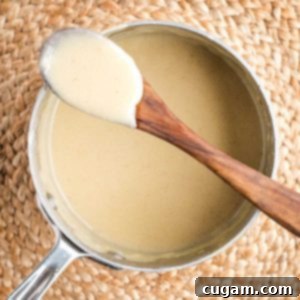
Vegan Bechamel Sauce
Rate this Recipe
Pin Recipe
Equipment
-
Small Sauce Pan
-
OXO Good Grips 11-Inch Balloon Whisk
Ingredients
- ¼ cup olive oil
- ¼ cup cassava flour
- 2 cups cashew milk
- ½ teaspoon sea salt
- ⅛ teaspoon white pepper
- pinch nutmeg
- 1 tablespoon light miso
Instructions
-
Heat small saucepan over medium-low heat. Pour in olive oil and leave for 30 seconds to warm.
-
Sprinkle in flour and whisk constantly. This is the part that’s called a roux. You want to cook off the raw flavor, but don’t cook it long enough for it to turn brown. It will turn quick thick and pasty at this point. It’s OK if it mostly gets stuck in the whisk.
-
Whisk in 2 tablespoons of the milk. The mixture may even get thicker. Pour in another few tablespoons of milk and keep whisking. Continue to add a few tablespoons of milk at a time, stirring in between until the liquid has been evenly dispersed into the sauce. Use all but ¼ cup of the milk.
-
Be prepared for the sauce to go back and forth from being too thick and super pasty, to smooth and creamy. As the new addition of milk heats up, the sauce will thicken…and as you continue to whisk and that addition is absorbed into the flour, the sauce will thin out. Over and over again, with each new addition.
-
When you get to the last ¼ cup of milk, add the miso paste and use a fork until it’s diluted completely into the milk. Then, add it to the sauce, and whisk until fully incorporated. Turn off heat and stir in salt, pepper and nutmeg.
-
Stir a few times as the sauce cools. Transfer to an airtight container and store in the refrigerator for up to a week or in the freezer for 3 months.
Notes
Olive oil: For an oil-free bechamel, substitute oil with vegetable broth. I found the finished product a bit less rich and creamy, but still a solid plant-based version of bechamel.
Milk: Use cashew milk, soy milk, oat milk or almond milk.
Make your own cashew milk: soak ½ cup raw, unsalted cashews in boiling water for 30 minutes. Rinse, drain and add to blender with 2 cups water. Process until smooth and creamy.
Serving size: Nutrition information was calculated based on one recipe yielding 2 cups bechamel sauce and a serving size of ¼ cup.
Nutrition
Note
The nutrition calculations were done using online tools. To obtain the most accurate representation of the nutritional information in any given recipe, you should calculate the nutritional information with the actual ingredients you used. You are ultimately responsible for ensuring that any nutritional information is accurate, complete and useful.
